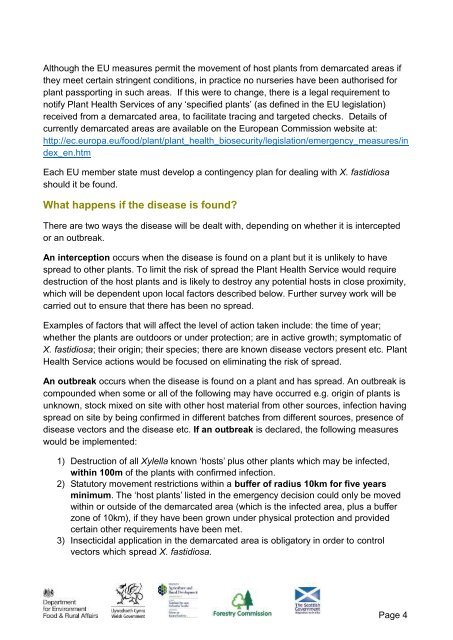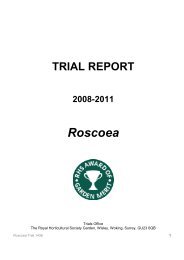Xylella fastidiosa
xylella-fastidiosa-impl-trade
xylella-fastidiosa-impl-trade
You also want an ePaper? Increase the reach of your titles
YUMPU automatically turns print PDFs into web optimized ePapers that Google loves.
Although the EU measures permit the movement of host plants from demarcated areas if<br />
they meet certain stringent conditions, in practice no nurseries have been authorised for<br />
plant passporting in such areas. If this were to change, there is a legal requirement to<br />
notify Plant Health Services of any ‘specified plants’ (as defined in the EU legislation)<br />
received from a demarcated area, to facilitate tracing and targeted checks. Details of<br />
currently demarcated areas are available on the European Commission website at:<br />
http://ec.europa.eu/food/plant/plant_health_biosecurity/legislation/emergency_measures/in<br />
dex_en.htm<br />
Each EU member state must develop a contingency plan for dealing with X. <strong>fastidiosa</strong><br />
should it be found.<br />
What happens if the disease is found?<br />
There are two ways the disease will be dealt with, depending on whether it is intercepted<br />
or an outbreak.<br />
An interception occurs when the disease is found on a plant but it is unlikely to have<br />
spread to other plants. To limit the risk of spread the Plant Health Service would require<br />
destruction of the host plants and is likely to destroy any potential hosts in close proximity,<br />
which will be dependent upon local factors described below. Further survey work will be<br />
carried out to ensure that there has been no spread.<br />
Examples of factors that will affect the level of action taken include: the time of year;<br />
whether the plants are outdoors or under protection; are in active growth; symptomatic of<br />
X. <strong>fastidiosa</strong>; their origin; their species; there are known disease vectors present etc. Plant<br />
Health Service actions would be focused on eliminating the risk of spread.<br />
An outbreak occurs when the disease is found on a plant and has spread. An outbreak is<br />
compounded when some or all of the following may have occurred e.g. origin of plants is<br />
unknown, stock mixed on site with other host material from other sources, infection having<br />
spread on site by being confirmed in different batches from different sources, presence of<br />
disease vectors and the disease etc. If an outbreak is declared, the following measures<br />
would be implemented:<br />
1) Destruction of all <strong>Xylella</strong> known ‘hosts’ plus other plants which may be infected,<br />
within 100m of the plants with confirmed infection.<br />
2) Statutory movement restrictions within a buffer of radius 10km for five years<br />
minimum. The ‘host plants’ listed in the emergency decision could only be moved<br />
within or outside of the demarcated area (which is the infected area, plus a buffer<br />
zone of 10km), if they have been grown under physical protection and provided<br />
certain other requirements have been met.<br />
3) Insecticidal application in the demarcated area is obligatory in order to control<br />
vectors which spread X. <strong>fastidiosa</strong>.<br />
Page 4



